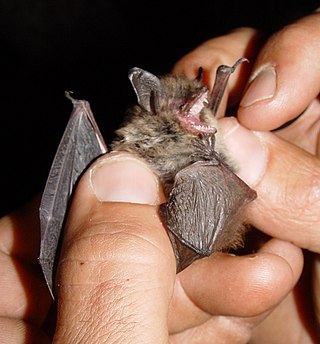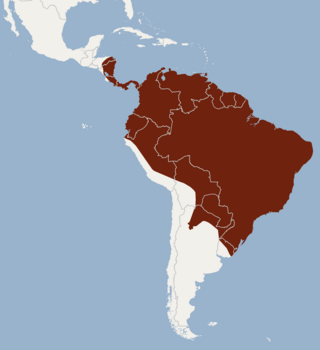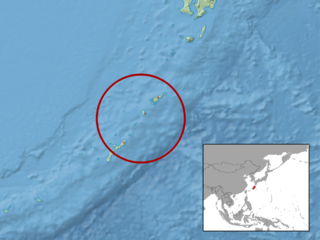
The mouse-eared bats or myotises are a diverse and widespread genus (Myotis) of bats within the family Vespertilionidae. The noun "myotis" itself is a Neo-Latin construction, from the Greek "muós and "oûs", literally translating to "mouse-eared".

The silver-tipped myotis is a species of mouse-eared bat found in a range of lowland habitats in the Americas.

The black myotis is a vesper bat species from South and Central America.

The riparian myotis, is a vespertilionid bat species from South and Central America. It is a medium-sized bat compared to other South American myotis.

The velvety myotis, is a species of vesper bat from South America.

Eptesicus is a genus of bats, commonly called house bats or serotine bats, in the family Vespertilionidae. The genus name is likely derived from the Greek words ptetikos 'able to fly' or petomai 'house flier', although this is not certain.

The southwestern myotis is a species of vesper bat. It is found in Guatemala, Mexico, and the United States.

The Australian myotis is a species of vesper bat. It is found only in Australia. This taxa may not represent a valid species. Only one specimen has ever been documented, supposedly from New South Wales. This specimen may have been mislabelled or a vagrant Myotis muricola or Myotis ater.

The Chilean myotis is a species of vesper bat found in southern South America.

The Yanbaru whiskered bat(Myotis yanbarensis) is a species of vesper bat in the genus Myotis.

The blunt-eared bat or Peruvian crevice-dwelling bat is a species of bat in the family Molossidae. It is monotypic within the genus Tomopeas and subfamily Tomopeatinae. It is endemic to Peru, where it is considered critically endangered. It is threatened by habitat loss.

Myotinae is a subfamily of vesper bats. It contains three genera: Eudiscopus, Myotis, and Submyotodon. Before the description of Submyotodon and analysis of its phylogenetics, as well as a phylogenetic analysis of Eudiscopus, the only member of Myotinae was Myotis.

The Chilean Matorral (NT1201) is a terrestrial ecoregion of central Chile, located on the west coast of South America. It is in the Mediterranean forests, woodlands, and scrub biome, part of the Neotropical realm.

The cinnamon red bat is a species of bat in the family Vespertilionidae. It was first described from a specimen that had been collected in Chile. For more than one hundred years after its initial description, it was largely considered a synonym of the eastern red bat. From the 1980s onward, it was frequently recognized as distinct from the eastern red bat due to its fur coloration and differences in range. It has deep red fur, lacking white "frosting" on the tips of individual hairs seen in other members of Lasiurus. It has a forearm length of 39–42 mm (1.5–1.7 in) and a weight of 9.5–11.0 g (0.34–0.39 oz).

The southern big-eared brown bat is a species of bat from the family Vespertilionidae. Although current taxonomy treats the southern big-eared brown bat as a separate species, it is often treated as a subspecies of the small big-eared brown bat. It lives in the forests of southern Argentina and Chile; though the population of the bat in the southern part of its habitat is low, there are no major concerns to justify anything lower than a Least Concern rating in the IUCN Red List.

Liolaemus atacamensis is a species of lizard in the family Liolaemidae. It is endemic to Chile, with occurrence noted in the Chilean matorral.
The slender broad-nosed bat is a species of bat in the family Phyllostomidae. As a phyllostomid bat, it is characterized by a narrow uropatagium which is fringed with hair; a white dorsal stripe; large inner upper incisors convergent at the tips; and three upper and three lower molars. It is found in eastern Colombia and Ecuador, north-eastern Peru, and Venezuela. It is closely related to Platyrrhinus incarum and Platyrrhinus fusciventris.
Myotis diminutus is a species of mouse-eared bat found in Ecuador and Colombia. It was recently described as a new species in 2011.

Myotis izecksohni is a species of mouse-eared bat that is endemic to Brazil and Argentina.
Promops davisoni is a species of free-tailed bat in the family Molossidae. It was first described by Oldfield Thomas in 1921. While thought of as a subspecies of the big crested mastiff bat by scientists from roughly 1966 to 2010, morphological and geographical differences between P. davisoni and P. centralis are sufficiently suggestive of another species. P. davisoni is small for its genus, with a forearm length of 47.6 to 52.0 millimetres, and is light or cinnamon brown with distinguishable white bands on its back. P. davisoni is native to the Andes mountain range in Ecuador and Peru. More recently, evidence has been found that P. davisoni resides in the Atacama Desert in Chile.


















